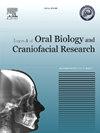双耳节拍与音乐选择作为儿童音频干扰行为指导技术:一项随机对照试验。
Q1 Medicine
Journal of oral biology and craniofacial research
Pub Date : 2025-01-01
DOI:10.1016/j.jobcr.2024.12.019
引用次数: 0
摘要
背景:双耳拍是将两种不同的纯音正弦波以小于30Hz的差异二分呈现而产生的。在牙科治疗中,孩子们在治疗过程中听熟悉的音乐,可以控制由旋翼或注射器等工具引起的焦虑,创造一个舒适、熟悉的环境。目的:评价和比较6-12岁儿童使用无音乐、选择音乐和双耳听觉节拍作为音频分心行为指导技术恢复性治疗期间的焦虑水平。方法:在儿科和预防牙科进行体内、双盲、三臂、平行组随机研究,将75名受试者分为3组。预备并修复原磨牙和恒磨牙I类蛀牙。在干预前和干预后分别用脉搏血氧仪和Venham图片测验测量焦虑。结果:与对照组相比,接受双耳节拍和选择音乐治疗的儿童的焦虑水平有所降低,这可以从Venham图像测试的焦虑得分和脉搏率值中看出。结论:双耳节拍和选择性音乐可以作为一种无创治疗方式有效地减轻小儿焦虑患者的焦虑。本文章由计算机程序翻译,如有差异,请以英文原文为准。

Binaural auditory beats vs music of choice as audio distraction behaviour guidance technique among children: A randomized controlled trial
Background
Binaural beat is created by presenting two different pure-tone sine waves with less than a 30Hz difference dichotically. In dental settings, children listening to familiar music during treatments gain control over the anxiety caused by tools like the airotor or syringe, creating a comforting, familiar environment.
Aim
To evaluate and compare anxiety level during restorative treatment using No Music, Music of choice and Binaural Auditory Beats as Audio distraction behaviour guidance technique in children aged 6–12 years.
Methods
In-vivo, double-blind, three-arm, parallel-group randomized study was conducted in the department of pediatric and preventive dentistry where 75 participants were allocated into 3 groups. The teeth with Class I cavity in primary and permanent molars were prepared and restored. Anxiety was measured pre- and post-intervention using Pulse oximeter and Venham's picture test.
Results
Children who were treated with Binaural beats and Music of choice showed reduction in anxiety levels as indicated by lower anxiety scores in Venham picture test and pulse rate values as compared to the control group.
Conclusion
Binaural auditory beats and Music of choice can be used effectively as a non-invasive treatment modality to reduce anxiety in apprehensive pediatric patients.
求助全文
通过发布文献求助,成功后即可免费获取论文全文。
去求助
来源期刊

Journal of oral biology and craniofacial research
Medicine-Otorhinolaryngology
CiteScore
4.90
自引率
0.00%
发文量
133
审稿时长
167 days
期刊介绍:
Journal of Oral Biology and Craniofacial Research (JOBCR)is the official journal of the Craniofacial Research Foundation (CRF). The journal aims to provide a common platform for both clinical and translational research and to promote interdisciplinary sciences in craniofacial region. JOBCR publishes content that includes diseases, injuries and defects in the head, neck, face, jaws and the hard and soft tissues of the mouth and jaws and face region; diagnosis and medical management of diseases specific to the orofacial tissues and of oral manifestations of systemic diseases; studies on identifying populations at risk of oral disease or in need of specific care, and comparing regional, environmental, social, and access similarities and differences in dental care between populations; diseases of the mouth and related structures like salivary glands, temporomandibular joints, facial muscles and perioral skin; biomedical engineering, tissue engineering and stem cells. The journal publishes reviews, commentaries, peer-reviewed original research articles, short communication, and case reports.
 求助内容:
求助内容: 应助结果提醒方式:
应助结果提醒方式:


